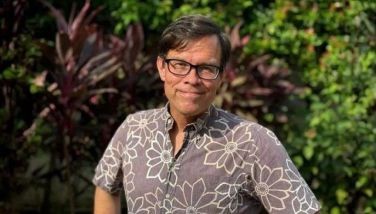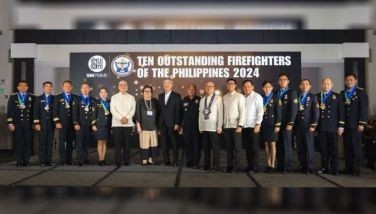Two for the road

I always admired and envied his gentle demeanor. How he made sure to pass by a busy alleyway in
That was in 2000, on a cold November, when he joined our UMPIL or Writers Union of the
Marne Kilates celebrated his birthday while we toured far-away
We always had a laugh whenever we walked into our room and the phone rang immediately, with a female voice inviting us to partake of “Mass-a-gee?” Obviously the caller was in cahoots with the front desk, and was quickly alerted every time we got back from our touring.
My most memorable day with him was when we toured the
We lost the crowds and found ourselves walking at a leisurely pace, appreciating the landscape that seemed classically Chinese, with tall bamboo stands alternating with pine trees along the rocky terrain. We talked of the power of meditation, and the delights of poetry.
Suddenly, a human figure shot up into the sky beyond some trees, about 10 meters away, startling us. The gorgeously clad figure descended just as swiftly, then flew back up again, long hair flying. It was a lady in medieval costume.
Sedfrey and I looked at one another, our eyes blinking in disbelief. Had we just witnessed an extraordinary martial arts display? As we rounded the bend, the marvel we had seen reverted to reality. A movie crew was positioned in a glade partly hidden by tall pines. But we easily espied a mechanical crane, and the flying lady who had obviously been wired up to account for her hang-time feats.
Later in our room, as Sedfrey sipped warm tea, he remarked that he would not forget that sight, and our nice walk together through the
Earlier he had given me a warmly dedicated copy of his book, Nuclear Poems. He brought along a dozen copies as gifts to our newfound Chinese friends, with whom we discussed, over lengthy meals, the possibility of working together on translations, of our Filipino and English poems to Mandarin, and vice versa with theirs.
UMPIL chair Mike Bigornia always stood proud when he introduced our group and came to the part that with us was the honorable Sedfrey Ordoñez, Ambassador to the United Nations.
Indeed he was a man of many parts, having served as an outstanding lawyer, a managing partner of the Salonga, Ordoñez and Yap Law Office from 1953 to 1986, a lecturer of remedial law from 1950 to 1986 at various universities, a delegate to the 1970 Constitutional Convention in representation of the second district of Nueva Ecija, and as Solicitor General in 1986 and Justice Secretary from 1987 to 1989 under the Aquino administration.
As Philippine ambassador to the United Nations, he served from 1990 to 1992, then chaired the Commission on Human Rights from 1992 to 1995.
He was a bilingual poet, playwright and librettist. Among his works were Wounded Pearls (Mga Sugatang Perlas), a three-act play set to music as opera and performed at the New York City Town Hall in April 1992; Sikhay sa Kabila ng Paalam, a three-act play set to music by Dr. Francisco Feliciano and performed as music-drama; the lyrics of Heroique, set to music by Jeffrey Ching and performed in 1991; the lyrics of Pag-ibig, set to music by Dr. Lucrecia Kasilag, National Artist, and performed in 1994; Arayat Cabiao, a book of poems and plays in English and Filipino; and Life Cycle: 50 Years in Law and Letters, published in 1999, two years after Nuclear Poems.
Sedfrey Ordoñez passed away at 86 on Nov. 18. We shall miss him. My personal regret is that I was out of town during his wake, and thus failed to give proper condolence to the family he left behind: his wife Josefina and children Roberto, Philip, Cristina and Helen.
Two Sundays ago, Marne Kilates’ Three China Poems appeared in print in a magazine. I texted him to say it must be his farewell tribute to Sedfrey, as those poems were occasioned by our visit to
Here are some lines from the third poem, “South of the Clouds,” which we can offer in recollection of our friendship with Sedfrey:
“Between
Last Wednesday, another friend and esteemed writer left us. Our PLAC (Philippine Literary Arts Council) coterie — Jimmy Abad, Ricky de Ungria, Susan Lara, Marj Evasco, RayVi Sunico, Juaniyo Arcellana and myself — had just paid a visit to dear Adrian Cristobal at Makati Med (with Susan, Jimmy and I also paying our respects and healthful wishes to Rene Saguisag a floor below), when separately we began to receive a litany of mournful SMS.
Rene Villanueva, playwright, writer of children’s literature, holder of the most number of Carlos Palanca Memorial Awards for Literature (at something close to 30), had just passed away at the Philippine Heart Center. He was 53.
Like Sedfrey, Rene’s remains lay in state at Sanctuarium on Araneta Avenue, before being transferred last Saturday morning to the Hardin ng mga Diwata by the UP Faculty Center in Diliman. The UP Writers Night last Saturday was sadder without him up and about.
I give way in this space to excerpts from Marne Kilates’ blog in tribute to dear Rene:
“We literally ‘grew up’ together in the Philippine literary community (though he was way, way ahead in most things). We were young writers attending the weekend workshop of the Galian sa Arte at Tula, founded by National Artist Virgilio S. Almario (Rio Alma), together with other writers in Filipino, notably Fidel Rillo, Romulo Sandoval (deceased), Reuel Molina Aguila, Tomas Agulto, Danilo Consumido, Ompong Desuasido, Ramon Villegas, Virgilio V. Vitug, Jesus Manuel Santiago, Mike Bigornia and Teo Antonio, among others....
“Although one of the youngest, Rene was the ‘fastest’ (in that other sense) among us in carving a name for himself, first as children’s book writer for the growing Adarna Series, winning international awards, then as head writer for the local version of Sesame Street, the now institutional Batibot, then as an award-winning playwright, with play after play of his being produced in various venues, from school campuses to the Cultural Center of the Philippines. (He later joined the Palanca Hall of Fame.)
“Friendships were further cemented by the amber liquid of San Miguel that we shared and consumed almost daily after work hours. Even our wives started to get together, mainly at Christmas for a special dinner for four young couples — Mike and Tek Bigornia, Teo and Sol Antonio, Rene and Ann Villanueva, your blogger and former wife, Alice. Teo called the four of us Quadro de Jack (after the ersatz cowboys of the comic book novel and later, the movie). When Mike Bigornia succumbed to a heart attack in the prime of his life to the shock of the literary community, Teo rechristened us Tatlong Baraha. Teo and I survive as — Jack and Jill? Franny and Zooey? Pat Salem and Dinky Doo? We try to continue writing poems.
“Rene was one whose discipline and persuasion in writing was to stay close to the people and the place he knew and loved (mainly the La Loma district in Quezon City), and to derive his writing from there, as well as dedicate his talent and knowledge to them. Up to the end, despite the sophistication and breadth of imagination he had developed — in his teaching, mentoring in workshops, and his travels — he always wrote for and about them. Although he confessed to envying (and looking up to) in his younger days the writers in English their apparent stylistic ‘superiority’ in language, their ‘culture’ that always found their way to print, he later asked why this was so.
“‘Mayaman sa kuwento ang mahihirap,’ he wrote in his book Personal, ‘ang mga walang mataas na pinag-aralan, ang mga kapos sa sopistikasyon at urbanidad.’ And so he wrote for and about them, and their heroes in history who, apart from fighting for national independence, sought their relief from poverty in its many forms, including the poverty of human dignity.
“This is my personal memory of Rene. But his public legacy is not hard to trace. Among the people, the children he wrote for and loved, he cannot fade; and the libraries, television, the Net, have a lot of his works literally on record. I did not find it difficult to look his name up. Google took me to local and foreign sites, university libraries, blogs... where he is mentioned, or where his biographical notes may be found. But I didn’t know that he blogged. What a waste, I should have written him at his Web page....”
Farewell, Sedfrey. Farewell, Rene. Mabuhay kayong dalawa!



















